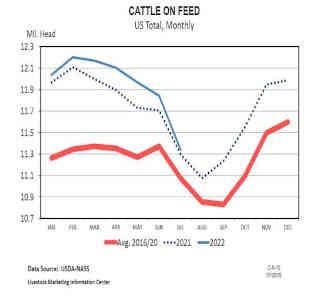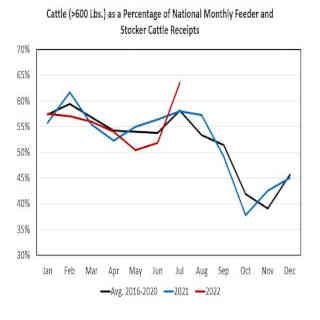By James Mitchell
This Friday, USDA-NASS will release the August Cattle on Feed report. Of particular interest is the feeder cattle placement data for July. Last month drought conditions spread across the Southern Plains and into the Southeast. Not only have producers had to cull deeper into their cow herds, but they have also had to sell feeder cattle earlier than expected. The August COF report should provide some answers about drought-induced feedlot placements.
The U.S. calf crop peaked in 2018 at 36.3 million head and has declined on average by 1.1% for 2019-2021. In the July Cattle Inventory report, USDA estimated the 2022 calf crop at 34.6 million head or 1.4% lower year over year. USDA also estimated July 1 feeder cattle supplies at 35.7 million head, 3% lower than 2021. Tighter supplies are coming and might already be here.

So far, 2022 feedlot placements are averaging 0.4% above 2021. However, when you remove February (February 2021 winter storm), 2022 feedlot placements are averaging -1.5% below 2021. In June, placements were 2.5% lower year over year. July 1 cattle on feed totaled 11.3 million head or 0.4% above July 1, 2021. Drought-induced placements in July could hold August 1 cattle on feed numbers close to or slightly above August 2021 feedlot inventories.
Seasonally, we tend to see larger placements of heavy feeder cattle (greater than 700 lbs.) in August and September. July is a seasonal low in feedlot placements. National feeder and stocker cattle auction receipts totaled 529,700, 1.2% lower than July 2021. While total auction receipts are lower for July, the break-out by weight group suggests that we are seeing cattle come off summer pasture earlier than normal. Last month 63% of feeder cattle auction receipts were for cattle weighing over 600 lbs. Cattle weighing over 600 lbs. accounted for 58% of auction receipts in July 2021. Auction receipt totals and these percentages imply that we sold 25,421 more head of heavy feeder cattle last month than in July 2021.
The longer we delay the decline in feedlot inventories, the more significant it will become. As Josh discussed a few weeks ago, the spread between CME Feeder Cattle futures contracts suggests that traders expect tighter supplies and higher prices. As of this writing, there is a $4.15/cwt spread between the Nov 2022 and Sep 2022 Feeder Cattle futures contracts. The Apr 2023 contract is trading $7.72/cwt above the Sep 2022 contract.

Source : osu.edu